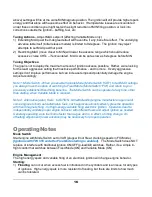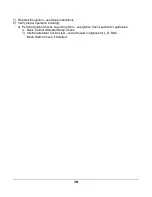
14
Blast target
Blast Tube Cooling
E-MAGs are designed for a high-heat environment, but there are still
thermal limitations and benefits to keeping the equipment as cool as
possible. Blast tube cooling is a simple way to reduce operating
temperatures, and we consider them mandatory. Blast tubes should
be directed at the
round neck, immediately behind the mounting
flange.
The mere presence of blast-tubes does not guarantee they are
operable and/or effective. After initial operations, operators can verify
the ignitions are within temperature guidelines (under 200F during
flight). A thermal reactive label is installed on the electronics case.
Alternatively, a thermal probe can verify ignition case temperatures at
the forward section of the electronics (box shaped) compartment.
Electrical System Condition
E-
MAG’s power dip protection helps guard against severe voltage
drops that occur when the starter motor is engaged. However, in the event of a compromised
electrical system (low battery, long cable runs, undersized cable, corroded terminals, cold engine,
etc.) bus voltage may not rebound as the starter speeds up (as is normal). A properly designed
and functioning electrical system is essential for the ignition to work properly. If bus voltage drops
below a certain level while cranking, a safety circuit may prohibit the ignition from firing. The starter
motor pulls the largest load on the electrical bus. Keeping non-essential loads turned OFF while
cranking will help
. Note: We have no definitive guidance, but there is some indication light-weight
lithium batteries may contribute to greater ignition voltage dips during startup.
Pull -Thru Test
The Pull-Thru test will confirm 1) plug wire assignments, 2) basic operation of firing circuits, and 3)
correct DIR as follows:
1. Remove all spark plugs from the engine and reconnect them to the plug leads.
2. *IMPORTANT* Rest each plug on the engine case or convenient location such that the
metal jacket of each plug is grounded to the engine block.
Alternatively, the plug metal
jackets can be wired to the engine block or plugs can be bundled directly to each other with
metal jackets in direct contact of each other.
3. One ignition at a time: Turn bus power ON, Kill Switch ON, and (if installed) Mode Switch to
VAR. LED will be steady RED. Rotate the prop by hand in the normal direction of travel
and confirm all plug pairs fire in proper sequence. Any deviation indicates a wiring or setup
error
.
•
Both plugs for cylinders 1&2 (Bank A) fire at the starting lag position (roughly 4-degrees
after TC).
•
Both plugs for Bank B fire 120 degrees later
– see Note 3
.
•
Both plugs for Bank C fire 240 degrees later
– see Note 3
.
Note 1: Plugs will not fire:






























